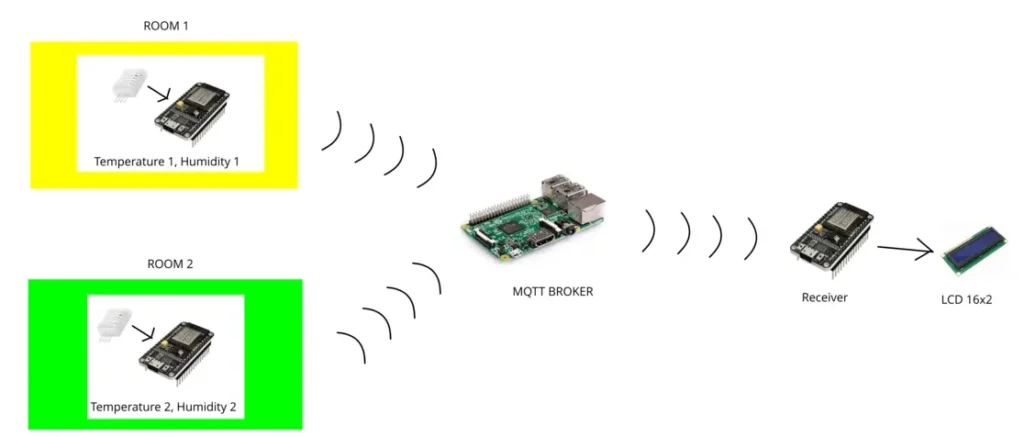Introduction
Welcome to the world where connectivity and interaction between devices are made possible thanks to
MQTT protocol in IoT. If you are interested in learning more about this versatile protocol, you are in the right place.
MQTT, an acronym for Message Queuing Telemetry Transport, is a lightweight messaging protocol
efficient that has established itself as the ideal platform for IoT. With a client-server architecture, MQTT
supports reliable and secure communication between resource-constrained devices, such as sensors.
In this introductory guide, we will learn about the fundamental principles of MQTT. We will explore how the
protocol and its publish/subscribe model. We’ll show you how MQTT can handle the
data efficiently, with reduced latency and optimized power consumption.
Furthermore, we will discover the real applications of MQTT in IoT. We will see how it is widely used in different
sectors, such as industrial automation, home automation and even the energy sector.
If you’re an IoT enthusiast or industry professional, this guide will give you a solid foundation
knowledge about MQTT and its importance in the world of IoT.
An example of use of this protocol can be found in the article DIY IoT: ESP8266 and Raspberry Pi to monitor temperature and humidity via MQTT communication protocol.
What is the MQTT protocol?
The MQTT protocol is a lightweight messaging protocol based on a
publication/subscription. It was designed to enable communication between devices with resources
limited, such as sensors and IoT devices. MQTT is characterized by low latency, low network overhead and a
low power consumption, making it ideal for IoT
Why MQTT is the ideal protocol for embedded IoT systems?
MQTT has become a core protocol for IoT for several reasons. Firstly, its lightness
allows devices with limited resources to communicate efficiently. Furthermore, the model of
MQTT publish/subscribe enables flexible and scalable communication between devices. In the end,
MQTT supports reliable and secure connection between IoT devices, ensuring secure transmission of data
data.
Features and benefits of MQTT
MQTT offers several features and benefits that make it suitable for IoT. One of the key features is
its lightness, which allows devices with limited resources to use the protocol without problems.
Additionally, MQTT supports QoS (Quality of Service), allowing you to ensure reliable delivery of data
messages. MQTT also supports message persistence, which means that messages are not lost
even in the event of temporary disconnection of the devices.
MQTT vs. other protocols for IoT
There are several protocols used in IoT, but MQTT stands out with some unique features. TO
Unlike other protocols, MQTT is lightweight, efficient, and supports reliable communication between devices
with limited resources. Some competing protocols, such as HTTP, may have network overhead and a
excessive power consumption for IoT devices. MQTT, on the other hand, is optimized for IoT and delivers
a more efficient alternative.
How MQTT works – publish-subscribe model
The publish/subscribe model is one of the key features of MQTT. In this model, i
devices are divided into two main roles: publishers and subscribers. Publishers send messages to a
specific topic, while subscribers subscribe to a topic to receive messages related to that topic.
MQTT manages the distribution of messages to interested subscribers, making communication efficient and
scalable.
Implementation of MQTT protocol in IoT applications
MQTT can be implemented in various IoT applications, enabling communication between devices. For
implement MQTT, you need an MQTT broker that acts as an intermediary between devices. The broker receives
messages from publishers and sends them to the corresponding subscribers. IoT devices act as MQTT clients and yes
they connect to the broker to send and receive messages. This client-server architecture makes MQTT flexible and
scalable for IoT applications.
The following image illustrates a possible architecture using this protocol:

MQTT broker and client
The MQTT broker is the heart of the MQTT system. Acts as an intermediary between publisher and subscriber devices,
managing the distribution of messages. The broker receives messages from publishers and sends them to subscribers
corresponding based on the topics subscribed to. MQTT clients are the devices that connect to the broker for
send and receive messages. Clients can be both publishers and subscribers, depending on their needs.
MQTT security considerations
Security is a key consideration when using MQTT in IoT applications. MQTT supports
various security features, such as authentication and authorization. You can use mechanisms
authentication such as username/password or digital certificates to ensure only authorized devices
can connect to the MQTT broker. Additionally, MQTT supports secure data transport via TLS (Transport
Layer Security).
MQTT use cases in different industries
MQTT is widely used in different industries to enable IoT. In the industrial automation sector,
MQTT is used to monitor and control manufacturing processes. In home automation,
MQTT allows the control of lights, appliances and security systems. In the energy sector,
MQTT is used to monitor and manage smart grids and power generation systems
renewable. These are just a few examples of the endless possibilities offered by MQTT in the IoT
Conclusions
MQTT has established itself as the ideal protocol for IoT thanks to its lightness, efficiency and support for
reliable communication between devices with limited resources. With its publish/subscribe model,
MQTT enables flexible and scalable communication between IoT devices. With its numerous applications
across industrial, home and energy sectors, MQTT continues to prove its value in IoT. If you are
interested in IoT, you cannot ignore the MQTT protocol.
Newsletter
If you want to be informed about the release of new articles, subscribe to the newsletter. Before subscribing to the newsletter read the page Privacy Policy (UE)
If you want to unsubscribe from the newsletter, click on the link that you will find in the newsletter email.
🔗 Follow us on our social channels so you don’t miss any updates!
📢 Join our Telegram channel to receive real-time updates.
🐦 Follow us on Twitter to always stay informed about our news.
Thank you for being part of our TechRM community! 🚀